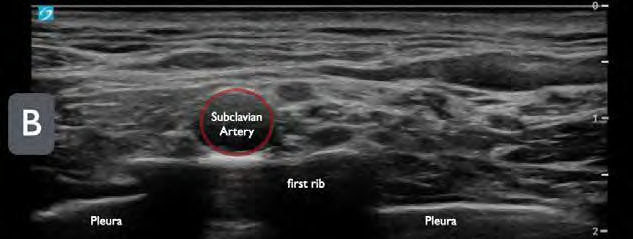
Injuries to the upper extremity (e.g., fractures, dislocations, lacerations, abscesses, and foreign bodies) are common, but can be challenging to manage in the emergency department (ED) due to severe pain.1 Procedural sedation and/or hematoma blocks can be great tools for pain control but, in our experience, often fail to provide adequate analgesia. While the use of hematoma blocks for lower forearm injuries such as distal radius fractures have been shown to be effective, there is little evidence suggesting that they are effective in upper arm injuries.2-4 Also, procedural sedation requires significant resources (e.g., additional nursing staff, a respiratory therapist, and monitoring equipment).5-7
Explore This Issue
ACEP Now: Vol 42 – No 04 – April 2023Single-injection, ultrasound-guided, brachial plexus blocks provide targeted analgesia for upper extremity injuries. Specifically, the interscalene block is effective for proximal injuries including the deltoid and shoulder and the supraclavicular block may be ideal for injuries at the elbow or lower.8 The supraclavicular brachial plexus block has a number of advantages including visualization of the brachial plexus, clearly defined ultrasonographic landmarks, and having been used for various arm injuries (from distal humeral injuries to distal radius fractures) in our ED. By delivering sonographically guided anesthesia, we can effectively reduce pain, opioid utilization, and need for procedural sedation.
The following sections outline important clinical anatomy, equipment for the block, and procedural steps that will allow for a successful supraclavicular brachial plexus block.
Indications and Considerations
The supraclavicular brachial plexus block is indicated for anesthesia and analgesia to common ED injuries below the shoulder including but not limited to: deltoid abscess, midshaft and distal humerus fractures, and elbow dislocations. For simplicity we think of the interscalene brachial plexus block for injuries from the proximal shoulder to the distal humerus and the supraclavicular brachial plexus block for injuries beyond the distal humerus.8 The decision to perform a brachial plexus block is a multifactorial decision. The clinician should be aware of the patient’s underlying medical history as well as have clear communication with the other services who may need to be involved in the patient’s care. Also, in our experience, sonoanatomy of the brachial plexus can be varied (both in location and overlying vasculature). Finding the right location (whether supraclavicular or interscalene) or not performing the block will depend on the patient’s underlying sonoanatomy as well as the ability to position an acutely injured patient.
Allergies, overlying infections, and coagulopathy are important contraindications, as with all peripheral nerve blocks.9 There are a few important limitations to the supraclavicular brachial plexus block that should be considered:
Pages: 1 2 3 4 5 | Single Page





No Responses to “How To: The Ultrasound-Guided Supraclavicular Brachial Plexus Block”